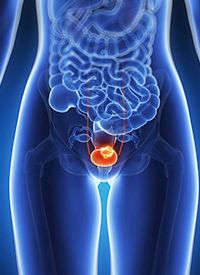New Bladder Cancer Recurrence Monitor Provides Non-Invasive Alternative for NMIBC Surveillance
Patients with a history of non-muscle invasive bladder cancer may not have to undergo multiple cytoscopies during routine follow-up, according to data on a new procedure for monitoring RNA indicators of disease recurrence in urine samples.
bladder

Patients with a history of non-muscle invasive bladder cancer (NMIBC) may not have to undergo multiple cytoscopies during routine follow-up, according to data on a new procedure for monitoring RNA indicators of disease recurrence in urine samples.
Data reported during a poster discussion session at the 2017 Global Congress on Bladder Cancer (GCBC) demonstrated that The Xpert Bladder Cancer (BC) Monitor was equal or superior to cystoscopy/cytology in all parameters evaluated including sensitivity, specificity, and diagnositic accuracy.
“This is the first report that the Xpert BC Monitor, a new mRNA based urine test, is superior to standard cytology in sensitivity and negative predictive value, even in low-grade and pTa tumors, with no reduction of specificity,” said lead author Renate Pichler MD, department of urology at the Medical University Innsbruck in Innsbruck, Austria.
After successful treatment, NMIBC requires follow-up that consists of cystoscopies and cytologies due to the high rate of recurrence that approaches 70%. Cystoscopy is an invasive endoscopy of the bladder that requires urethral catherization, which may affect patients’ adherence to follow-up.
To address this problem, Pichler and his team developed the Xpert Bladder BC Monitor, a non-invasive validated PCR-based assay of urine markers that could reduce the number of cystoscopies in routine recurrence surveillance. The devices analyzies urine samples to measure five target mRNAs (ABL1, CRH, IGF2, UPK1B, and ANXA10) that are indicators of disease recurrence.
This validation study compared the accuracy of the Xpert Monitor to cystoscopy and cytology for follow-up of patients with resected NMIBC. Investigators prospectively enrolled 140 previously-treated patients who were undergoing routine follow-up at the urology department of the Medical University Innsbruck. Fourteen patients underwent bladder washing cystoscopy together with urine cytology that was evaluated according to the Paris classification system, and 36 patients had an evaluation of a urine sample using the Xpert system.
The majority of patients were men aged 85 years and older. Twenty-one patients had tumors <3 cm and 13 patients had tumors ≥3cm. Twenty-four patients had low-grade disease and 12 patients had high-grade disease. Twenty-seven patients had Ta disease, 2 patients had tia, 5 had T1, and 2 patients were classified as >T1. These patient characteristics were balanced between assay arms.
The investigators conducted a descriptive analysis of the diagnostic accuracy of the monitor compared to conventional cystoscopy/cytology that included sensitivity, specificity, positive predictive value (PPV), and negative predictive value (NPV). They also calculated the receiver operating characteristic (ROC) curve and area under the curve (AUC).
Overall sensitivity of the Xpert Monitor was 0.84 and NPV was 0.93 compared with a sensitivity of 0.33 and NPV of 0.76 with bladder washing (barbotage) cytology (P<.001).
The sensitivity of the monitor was 100% in patients with high-grade tumors compared to 83% with bladder washing cytology. Subgroup analyses according to disease grade confirmed that the sensitivity was superior with the Xpert BC Monitor compared with barbotage cytology for low-grade tumors (77% vs 13%), pTa tumors (82% vs 21%), single tumors (68% vs 18%), and in tumors <3 cm (75% vs 29%). Similar overall specificity was reported for Xpert BC Monitor of 0.91 compared to 0.94 with barbotage cytology (P= 0.41). “The ROC curve analysis confirmed the diagnostic superiority of the Xpert BC Monitor,” Pichler said.
AUC analysis also favored the monitor (AUC = 0.87; 95% CI, 0.80 to -0.94;P= .001) over barbotage cytology (AUC = 0.63; 95% CI, 0.520.74;P= .013)
Investigators then evaluated whether the diagnostic accuracy of the Xpert BC Monitor could be improved by using the two procedures together. They did not observe an improvement in improve diagnostic performance compared with the monitor alone (AUC = 0.85 vs AUC = 0.87).
“The Xpert Bladder Cancer Monitor provides an opportunity to improve the current standard of care in NMIBC follow-up by providing higher sensitivity than cytology and reducing the invasiveness in bladder cancer patients,” Pilcher said. “This encouraging hypothesis-generating study calls for further prospective, randomized trials with sufficient statistical power to draw a full conclusion.”
These findings have also been published on September 20, 2017 in the British Journal of Urology International.
Reference:
Pilcher R, Josef F, Gennadi T, et al. Xpert Bladder Cancer Monitor for bladder cancer surveillance: first experiences from a novel MRNA-based urine test. Poster presented at: the 2017 Global Congress on Bladder Cancer; October 5-6, 2017; Edinburgh, United Kingdom.